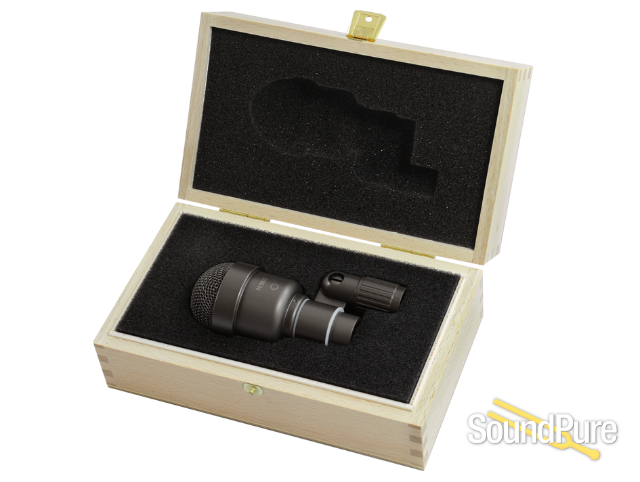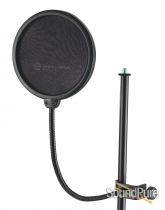-
Call Us Toll Free888-528-9703
-
Local/International (+1)919-682-5552
- Call Us! Toll Free! 888-528-9703
- Local / International (+1) 919-682-5552

$1,722.00
"Experience the Difference"
 Payments as low as $39/mo.
Payments as low as $39/mo.
888-528-9703
sales@soundpure.com
Manufacturer's Description from Gefell
The Gefell M960 is a compact large diaphragm omnidirectional microphone that has been corrected for the diffuse field to record the acoustic ambience of a performance by hanging the mic above and ahead of the source. A carefully tailored 'presence rise' ads intelligibility while off axis response is smooth and natural. Ideally suited for orchestra and choir in natural settings, the M960 is also adept at overhead studio mic'ing for recording and broadcast
Design Features
There are several factors critical to achieving at the M960s performance. To begin, the M960's precise voicing and exceptional sensitivity is achieved through the use of a large 1", hand-stretched gold evaporated membrane with a precision-machined back plate. This is specifically voiced with an obvious presence rise that begins at 4kHz and tapers back down at 12kHz. This has the effect of producing greater intelligibility and as such, allows the engineer to aim the mic "ahead" of the instruments capturing the natural balance of both the direct and the diffuse field.
Designed as a hanging mic, the "stubby" body is machined from solid brass and electro-plated in a dark-bronze to reduce visibility. The ultra-compact, rounded shape has been purposely designed to minimize its effect on the acoustic field while diffracting unwanted body reflections away from the capsule. This of course reduces the vortex around the mic and results in less phase distortion at the capsule, for improved articulation. The net bi-product of this unique mechanical design is an exceptionally smooth off-axis response.
As most engineers know, reducing the body size of a microphone to minimize its acoustical interference typically comes with a caveat: As one brings the circuit closer to the ultra-sensitive capsule, circuit noise may be induced. To solve the problem, the M960's circuit topology employs state-of-the-art transformerless semi-conductor technology combined with optical isolation to reduce "hash" and ripple from the typically unfiltered 48V phantom supply. Large, over-sized storage capacitors ensure a constant plate voltage assuring exceptional transient response. This unique approach brings the noise floor down well below the residual equipment noise and results in a smooth yet explosive impulse response that makes the M960 a star performer no matter what the setting.
Using the M960
The Gefell M960 is connected with a standard 3-pin XLR following the AES specification and only requires the 48V phantom powering. The unique body design and dark coloring makes placement easy and practically invisible. The omni-directional pick-up pattern is axial. Designed to capture both the ambiance and the source, the M960 is voiced with a pronounced presence rise that has been specifically tailored to pick-up the diffuse field. This allows the engineer to aim the mic in the vicinity of the source to achieve the desired balance between the instrument and the reverberant field.
The M960 comes equipped with a beautifully machined mic clip for use on mounting bars. When used on a stand where severe vibration-borne noise may be encountered, the optional EH93 isolation mount is recommended. The most common placement is hanging the M930 above and in front of the source. Placement is dictated by the engineer?s desired balance between the instruments and the intensity of the reverberant field in which the performance is to be recorded.
One should note that the Gefell M960 is not however limited to classical or jazz recording. In the studio, one may also use the M960 as a "far-field" mic to pick up the thunderous effect of a drum kit or to create larger than life renderings of guitar stacks. Like all good mics, creativity is the only limiting factor to the hundreds of possible applications!
Interpretation
The Gefell M930 is a unique microphone that combines the warmth, detail and added sensitivity of a large gold evaporated diaphragm inside a compact and unobtrusive body. It has been specifically voiced to capture the symbiotic relationship of the instrument and the diffuse reverberant field making it truly unique. By introducing the very latest technological advancements, The M930 yields exceptional transients while exhibiting extremely low self-noise. The net result is a microphone that is almost invisible to the ear and to the eye.
The M960 is ideal for choir, orchestra, and ensembles and is ideally suited for all venues including convert halls, churches, theatres and recording studios.

About Manufacturer
Since its founding by Georg Neumann in 1928, the company has produced high quality, condenser microphones for broadcasting and recording. Many models have used the M7 capsule originally designed by Mr. Neumann in 1949 for the CMV563a. The M7 was responsible for the legendary sound of the Berlin manufactured U47, U48 and M49 microphones. Today, under the technical supervision of Mr. Kuehnast's son, the Company still produces the M7 capsule in exactly the same way Mr. Neumann taught the elder Kuehnast in the 1940's. Hand drilling each hole in the backplate, making the PVC membrane, and even gluing it together by hand is done just as Mr. Neumann specified. The M7 is currently used in the UM 92.1S, UMT800, UMT70S and MT71S Gefell manufactured microphones.
Some of the production equipment which Microtech Gefell GmbH uses for capsule production capitalizes on advanced technology developed by the Soviets before Perestroika. One of the more recently developed microphones, the M300, uses a capsule made of ceramic material molded under high pressure and plated with chromium. This technology was developed in Moscow using advanced computer modeling and simulation techniques. Gefell perfected a capsule manufacturing process unlike any employed in making Western microphones.
The SMS70 series of microphones designed in the early 1970's used a hybrid amplifier with an fet stage. Hybrid technology was not adopted by manufacturers of Western microphones until the late 1980's. Microtech's newest amplifier for the UMT70S series microphones uses surface mount device (SMD) technology.
The company also manufactures a complete line of measurement microphones equivalent to those of Bruel & Kjaer, the Danish manufacturer. These microphones are tested to the highest standards currently used in the West. The manufacturing methods for the nickel membranes and backplate assemblies are highly advanced. Testing each microphone takes a minimum of three months to guarantee performance and stability when it leaves the factory.
Before the Reunification of Germany the company manufactured their studio and broadcast microphones for RFT, a state agency that distributed them to customers in the Eastern Bloc. Most of the microphones went into the broadcast system. Some microphones, like the PM 860, went into public address systems. Virtually every town hall and auditorium in the former Soviet Union has one. About 1985, the Company began developing high powered (30 to 100 Watt) industrial lasers. They still use a laser engraving machine to put the name and serial numbers onto microphones and other finished metal products. During this period, the East German government poured 60 Million Ost Mark into the company allowing them to buy sophisticated equipment and construct a new building.
Specifications
Pattern:Omnidirectional
Response: 20Hz ~ 20kHz
Sensitivity: 16mV/Pa
Self noise: 9dB A-weighted
Signal to noise: 85dB A-weighted
Maximum SPL: 145dB
Dynamic Range: 135dB
Power requirement: 48V phantom












